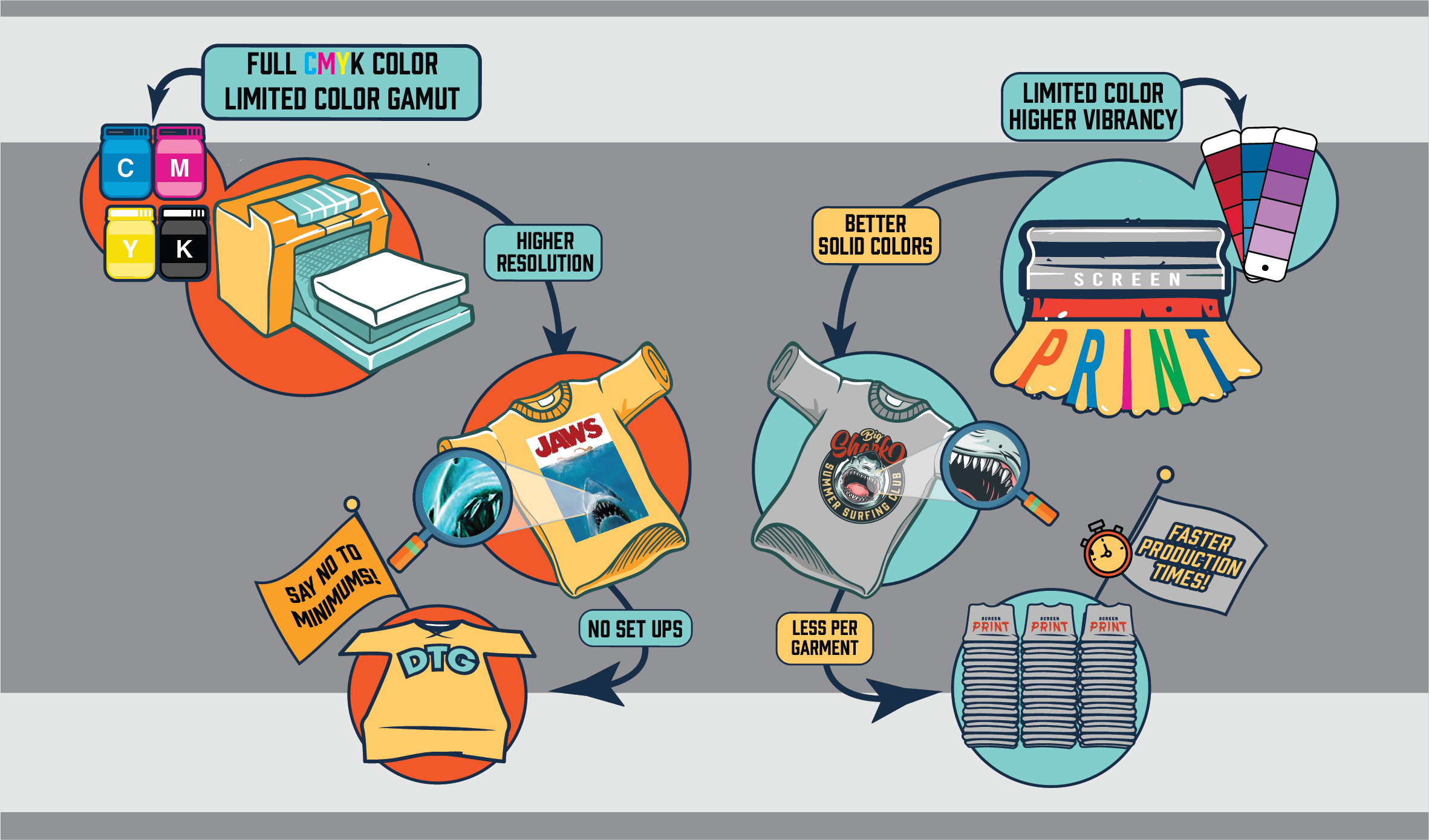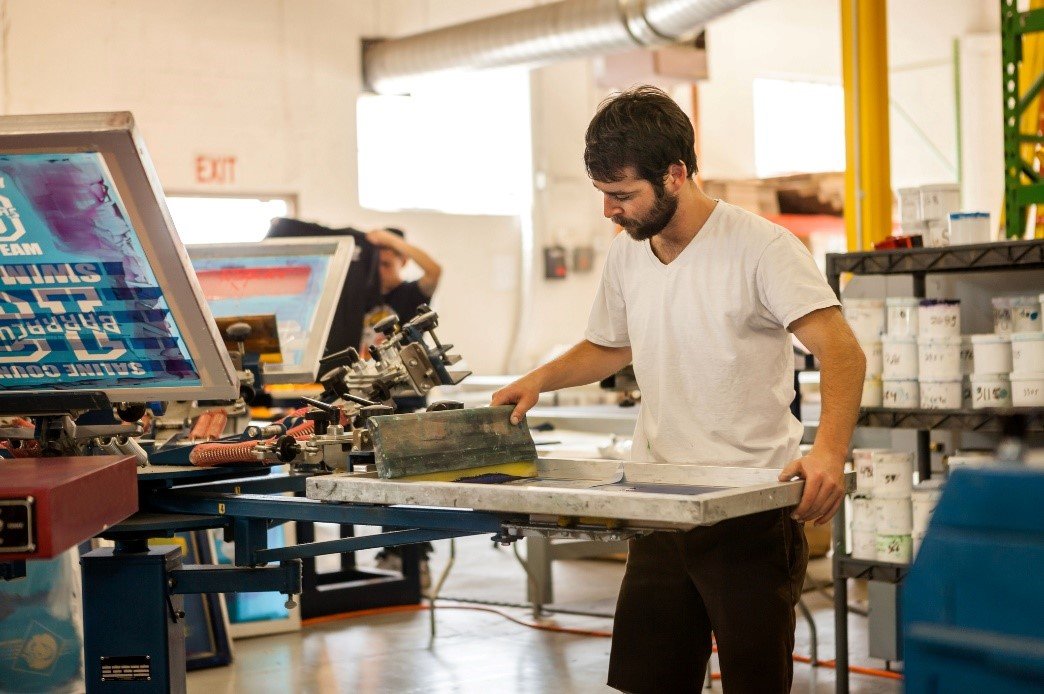Examine This Report on Tx Tees
Examine This Report on Tx Tees
Blog Article
Not known Incorrect Statements About Tx Tees
Table of ContentsSome Known Facts About Tx Tees.The 30-Second Trick For Tx TeesThe Best Strategy To Use For Tx TeesThe Of Tx TeesA Biased View of Tx TeesEverything about Tx TeesAll About Tx Tees
That brings your overall to roughly $1,900 gross and delivery. Add up various other prices, like the number of utilities it requires to run the shop and the price of ink and solution per design. t-shirt printing. Take the print below as an example. This is a one-color photo, so the expense of ink per t-shirt is approximately 20 cents.The solution should only be a couple of cents because you 'd only need to layer one screen for this work. Normally, printers try to make up to 45% profit on a print task.

With DTF, you can publish a handful of tee shirts, or just one. Both screen printing and DTF have their specific niches in the globe.
Excitement About Tx Tees
The very best way to understand? Ask about and see what print stores like your own are doing. t-shirt printing. Attempt both out and see which you like better
When you're picking what type of printing technique to make use of for publishing your artwork styles on your garments, it's important that you know the distinctions between these two strategies so you can optimize outcomes while reducing expenses. Display printing is one of the most commonly utilized method for publishing layouts on fabrics.
DTG printing is also known as area or straight to garment printing due to the fact that it publishes just what is needed as opposed to making a screen as screen printers do. https://yoomark.com/content/t-shirt-design-screen-printing-custom-embroidery-abilene-tx. Display printing functions by display filler squeegee screen printing ink screen mesh screen, then transferring the picture to garment making use of warmth and/or stress
The DTG printer uses special dye-sublimation inks that are applied into a pre-designed picture by an electronic printing system. The inks enter into the fabric, enabling dynamic colors and outstanding information. It's also known as place or straight to garment printing due to the fact that it publishes just what is required as opposed to making a screen as screen printers do.
Tx Tees Fundamentals Explained
First, it's much faster - you can print a fullcolor image in minutes, as opposed to hours for screen printing. Second, there's no established time or costs included - you can publish any kind of layout you like, without having to create a screen first. Third, there's no waste - because screen printers screen print one design at a time, they have to screen each color individually.
The paper is extremely costly and can just be utilized when. Once it's published on, it has actually to be disposed of. - The first acquisition rate is less than the ahead of time financial investment of DTG printers- You can publish multi-color layouts one screen at a time instead of needing to publish each shade independently like DTG printing.

The Tx Tees Ideas
However, rather of using display mesh as display printers do, dye sublimation printers utilize laser modern technology to transfer your photos onto garments or paper. A warmth process transfers the dye from its solid-state directly right into the gas stage which subsequently integrates it onto material substratums when they are swiftly heated to high temperature levels under high stress.
Sublimation printing is environment-friendly. It uses less water than screenprinting, and since it does not entail using dangerous solvents, it's secure for all kinds of apparel. The dye sublimation inks are likewise unsmelling when healed, unlike display printers that use hazardous chemicals during the display printing procedure that leave view it now an undesirable smell.
They additionally conserve cash on pricey tools like direct exposure units since dye sublimation printers don't require a UV direct exposure unit or a flash cure oven that is generally utilized in screen printing (screen printer). What is direct to garment printing (DTG Printing)? DTG printing is a digital screenprinting procedure that publishes straight onto textile making use of specialized inkjet printers
The Only Guide for Tx Tees
DTG printing supplies numerous advantages over typical screenprinting, consisting of the capability to publish photographic top quality pictures, better shade vibrancy, and the ability to print designs on darker materials. DTG printers function by warming the textile ink until it develops into a gas. The gas after that penetrates the material, bonding with the fibers to develop an irreversible print.

Screen printers just prepare their screen then start printing until they run out of product or ink.- There is a large range of seasoned display printers throughout the globe, which can be useful for novices. - It's a slower process - screen printers usually have to wait on the ink to completely dry prior to they can print the next color- Display printers call for hand-operated labor, so there's a greater understanding contour and it takes longer to create a high-grade layout- Display printing isn't as precise as DTG printing, so you may get some "blood loss" of colors from one part of the photo onto an additional otherwise done effectively.
The 25-Second Trick For Tx Tees
Instead of making use of screen mesh as screen printers do, dye sublimation printers make use of laser modern technology to transfer your images onto garments or paper. A heat process transfers the dye from its solid-state straight into the gas stage which subsequently merges it onto material substratums when they are swiftly warmed to heats under high stress.
Sublimation printing is green. It makes use of less water than screenprinting, and because it does not entail the use of unsafe solvents, it's safe for all types of clothing. The color sublimation inks are also odor free when healed, unlike display printers that make use of unsafe chemicals throughout the screen printing process that leave an undesirable odor.
They additionally save cash on pricey equipment like exposure systems since dye sublimation printers do not need a UV direct exposure device or a flash cure oven that is commonly used in screen printing. What is straight to garment printing (DTG Printing)? DTG printing is an electronic screenprinting procedure that publishes straight onto fabric using specialized inkjet printers.
How Tx Tees can Save You Time, Stress, and Money.
DTG printing uses lots of benefits over traditional screenprinting, consisting of the capacity to publish photo top quality pictures, higher color vibrancy, and the ability to publish layouts on darker materials. DTG printers work by heating the textile ink until it turns right into a gas. The gas after that penetrates the textile, bonding with the fibers to develop an irreversible print.
Report this page